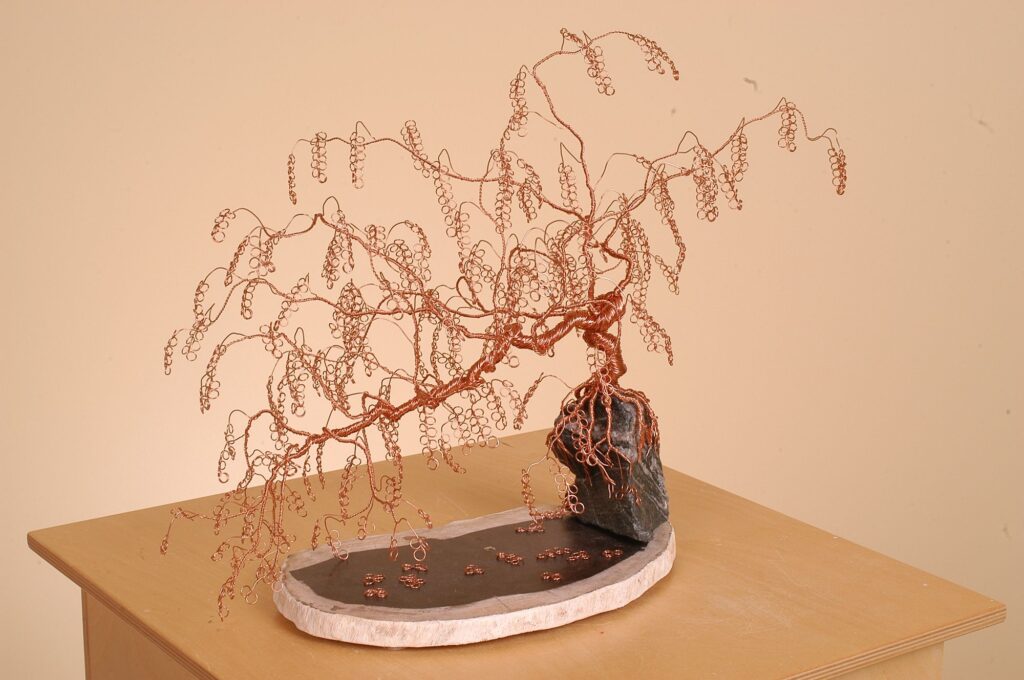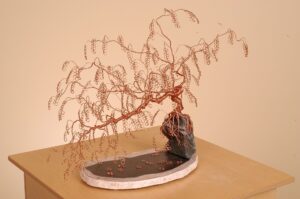
Wire art is a form of creative expression where wire is used to shape, sculpt, and define objects, figures, and abstract forms. Whether you’re crafting a small tree for your living room or constructing a large kinetic sculpture, the possibilities are endless. This guide explores everything you need to know about wire art — its background, the tools you’ll need, and how to get started on your own wire sculptures.
1. Introduction to Wire Art
Wire art is an artistic medium that transforms wire—usually made of aluminum, copper, brass, or steel—into decorative and expressive objects. Artists bend, twist, wrap, and shape the wire to form both abstract and realistic designs. This art form is not only affordable and accessible but also versatile enough to create small jewelry or massive sculptures.
Historically, wire art has roots going back to ancient Egypt and early European metalworking. Over time, it evolved from utility and ornamentation into an expressive artistic discipline. The transformation of a single wire strand into a meaningful object exemplifies how minimalism can produce great beauty. Whether displayed on a shelf, worn as jewelry, or suspended in mid-air, wire art draws attention through its unique linework and dimension.
2. Notable Artists and Styles in Wire Art
Wire art has grown as a medium, thanks to pioneers and modern artists who expanded its possibilities. Among the most influential is Alexander Calder, who introduced kinetic wire sculptures known as “mobiles” and “stabiles”. His whimsical wire portraits and abstract shapes earned him the title “father of wire sculpture.”
Ruth Asawa, another visionary, elevated wire art by crocheting wire into mesmerizing organic shapes that often resemble floating baskets or abstract jellyfish. Her work is admired for its delicacy and spatial depth.
In the contemporary scene, artists like Robin Wight create lifelike fairy sculptures from stainless steel, placing them in natural landscapes to evoke fantasy. Others, such as Brian Boyer and Gavin Worth, focus on minimalist, line-drawing-inspired figures that appear to be sketches lifted into three dimensions.
3. Materials and Tools for Wire Art
To create wire art effectively, it is essential to understand the types of materials and tools used. The choice of wire depends on your project:
| Wire Type | Characteristics | Best For |
|---|---|---|
| Copper | Soft, easy to bend, oxidizes beautifully | Jewelry, beginners |
| Aluminum | Lightweight, comes in various colors | Abstract sculptures |
| Steel | Strong and rigid | Large or structural art |
| Brass | Has a warm tone, semi-soft | Decorative elements |
Wire is available in different gauges, which refer to its thickness. A smaller gauge means thicker wire. For instance, 20-24 gauge is good for jewelry, while 14-18 gauge is better for freestanding sculptures.
Tools every wire artist should have include:
- Wire cutters for trimming pieces cleanly.
- Round-nose pliers for making loops.
- Chain-nose and flat-nose pliers for gripping and bending.
- Mandrels and jigs for consistent shaping.
These tools are inexpensive and widely available in art stores and online platforms.
4. Basic Wire Art Techniques
Mastering wire art starts with learning a few foundational techniques. These are the building blocks of nearly every project:
- Looping – Creating circular loops for joints or decoration.
- Coiling – Wrapping wire around itself or a mandrel to make spirals.
- Twisting – Combining two or more wires for added strength or texture.
- Wrapping – Covering a frame or another wire with a thinner wire.
- Weaving – Interlacing multiple wires for a braided or textile-like effect.
These techniques can be practiced on scrap wire before starting actual projects. Learning these allows you to manipulate wire with more precision and creativity.
5. Design Planning and Armature Construction
Before creating a sculpture, it’s essential to sketch or visualize your design. This step can be as simple as drawing your figure on paper or digitally tracing a reference image.
After the design stage, building a strong armature or frame is the next step. An armature serves as the skeleton for your sculpture and is usually made from thicker wire. For example, if you’re making a human figure, use 14-16 gauge wire for the limbs and spine. Thinner wires can be wrapped around it to define details like muscles or clothing folds.
The beauty of wire art is in its transparency. Viewers can see the form’s “bones,” and with careful shaping, even a simple piece can have depth and realism.
6. Types of Wire Art Projects
Wire art can be applied across several forms and scales:
- Jewelry Making: Wire-wrapped rings, pendants, earrings, and bracelets use thinner wires and require detailed handwork.
- Sculptures: Animals, birds, and fantasy creatures like dragons or fairies make excellent subjects.
- Wire Trees: A popular beginner project, these miniature trees have twisted wire trunks and branches, often decorated with beads for leaves.
- Wall Art: Minimalist wire portraits or line art mounted on wood backgrounds are trending in home decor.
- Kinetic Art: Mobiles and spinning sculptures bring motion into the equation, requiring balance and engineering.
Each project allows for personal expression and creativity, making wire art ideal for hobbyists and professional artists alike.
7. Step-by-Step Tutorials for Beginners
Starting with basic projects builds confidence and teaches essential techniques. Here’s an example tutorial:
Project: Wire Tree on a Stone Base
- Cut 6–10 pieces of 18-gauge wire, each about 12 inches long.
- Twist the wires together at the center to form the trunk.
- Separate the top halves into branches, twisting smaller segments.
- Shape the bottom wires into roots and wrap them around a small rock.
- Fan out the branches and adjust for symmetry.
You can apply similar steps for other beginner projects like heart-shaped pendants, name wire art, or simple animal outlines.
8. Advanced Techniques and Tips
Once comfortable with the basics, you can explore complex structures. Advanced wire art may include:
- Soldering: Fusing wire with heat for a cleaner, stronger bond.
- Multi-wire weaving: Using different gauges and colors for layered designs.
- Incorporating beads or fabric: Adding mixed media for texture and contrast.
- Surface finishing: Using oxidation, paint, or varnish to protect and beautify your sculpture.
Advanced artists also build kinetic wire pieces that rely on precise weight distribution to function correctly.
9. Safety Measures and Best Practices
Safety is vital in wire art. Thin wire can snap and cause injury, while thick wire can strain your hands. Always wear protective eyewear when cutting wire and use gloves if you’re handling rigid material.
Store wires in labeled coils to prevent tangling, and organize tools in a dedicated toolbox. Clean up after each session to keep your workspace safe and efficient.
10. Resources for Learning and Inspiration
If you’re eager to dive deeper into wire art, there are many resources to explore:
- Books like The Art of Wire or Sculpting in Wire.
- YouTube Channels offering tutorials for beginners and professionals.
- Online Communities such as Reddit’s r/wireart or Facebook groups.
- Local Classes or Workshops at art centers.
You can also browse Etsy and Pinterest for wire art inspiration and connect with creators around the world.
11. Conclusion
Wire art is a rich, expressive, and endlessly adaptable form of creativity. From simple loops to detailed sculptures, artists use wire to draw in space and tell stories without paint or canvas. With a few tools, some patience, and a vivid imagination, anyone can transform a humble coil of wire into something beautiful and unique.
Whether you are crafting jewelry, designing home décor, or building intricate figures, wire art welcomes both novices and experts into its fold. So pick up a spool of wire, start twisting, and let your ideas take shape.
5 Frequently Asked Questions (FAQs)
Q1. What is the best wire for beginners in wire art?
Soft copper or aluminum wire in 20–22 gauge is ideal for beginners. It’s easy to bend and shape without tools.
Q2. Can wire art be used outdoors?
Yes, but choose weather-resistant wires like galvanized steel or stainless steel, and consider applying protective coatings.
Q3. Is wire art expensive to start?
Not at all. You can start with basic pliers and a few feet of wire, which is often under $10.
Q4. How do you display wire sculptures?
They can be mounted on wood, framed behind glass, hung with fishing wire, or fixed onto stone bases.
Q5. Can kids try wire art safely?
Yes, with supervision. Use flexible, blunt wire types and avoid sharp tools until they’re older and experienced.




